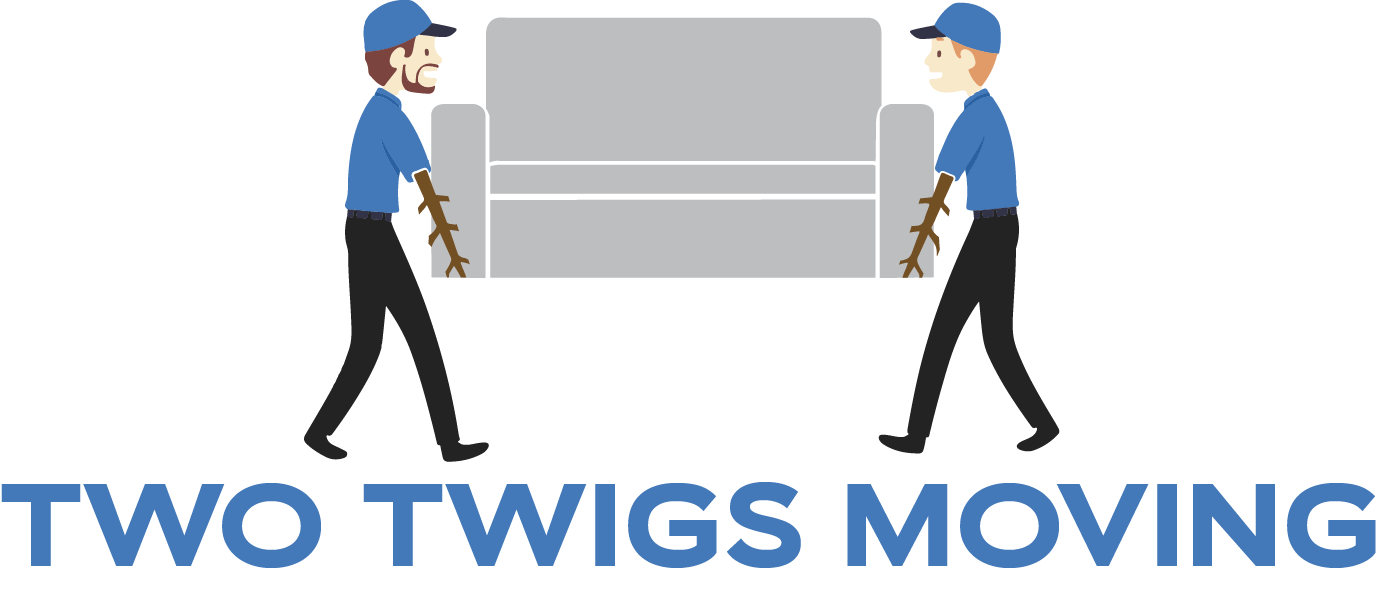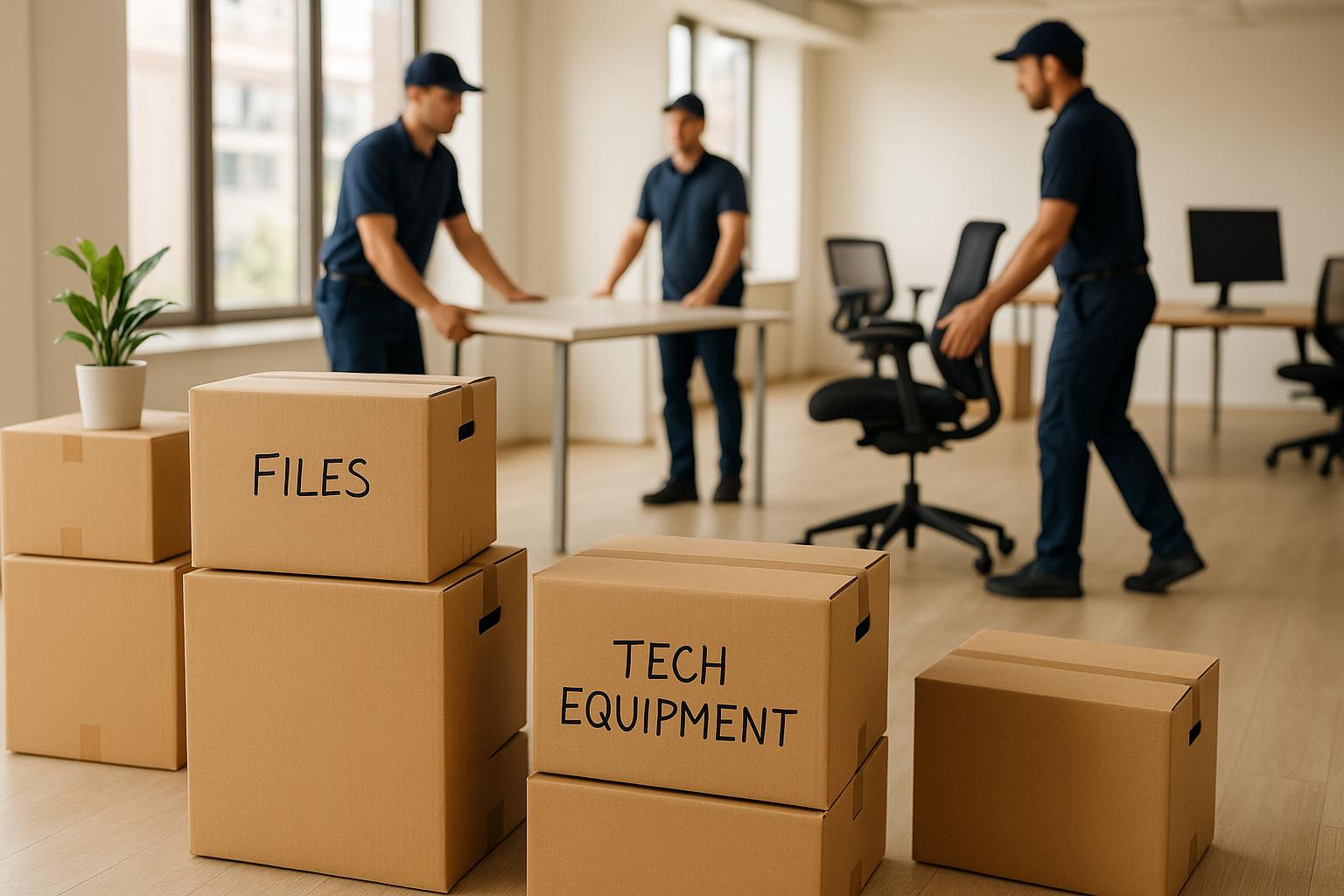- Start Early: Plan your move 6–12 months in advance to avoid last-minute problems.
- Hire Professionals: Movers like Two Twigs Moving handle packing, transporting, and setup to reduce downtime.
- Organize Your Inventory: Decide what to keep, upgrade, or discard. Label everything for easy unpacking.
- Minimize Downtime: Schedule moves during off-peak hours, like evenings or weekends.
- Prepare IT Systems: Back up data, test new office networks, and ensure equipment is ready to go.
- Budget Wisely: Costs depend on office size, distance, and services needed. Small moves start around $1,000, while larger ones can exceed $30,000.
- Communicate with Your Team: Keep employees informed and involved to ease the transition.
Professional movers like Two Twigs Moving can handle everything from packing to reassembling furniture, ensuring your business is up and running quickly. Ready to move? Get a quote today and make the process hassle-free.
Planning Your Office Move
Getting ready for an office move can feel overwhelming, but starting early and staying organized can help minimize disruptions. The trick is to create a detailed plan and stick to a well-structured timeline. With enough preparation, you can keep your team focused and productive throughout the process.
Creating a Moving Timeline
To set yourself up for success, begin planning 6–12 months ahead of your move. This gives you the flexibility to handle any unexpected hiccups and secure the best moving dates. As Patrick Isitt, Senior Content Manager at Oktra, explains:
"An office move should be planned approximately 12 months in advance for a 10,000 sq ft project. You can usually add or subtract six months per 5,000 sq ft."
Start by reviewing your lease for any deadlines or notice requirements – these are typically 60–90 days – and avoid unnecessary penalties. Assigning a project manager is crucial; they’ll act as the go-to person for coordinating vendors, managing timelines, and keeping track of all the moving parts.
Your timeline should include key milestones like hiring movers, designing the new office layout, scheduling IT installations, and setting a realistic budget to cover moving costs and unexpected expenses. Once your timeline is mapped out, you can dive into assessing your office’s specific needs.
Assessing Your Office’s Needs
With your timeline in place, take a closer look at your office assets to decide what’s worth moving and what isn’t. Create a detailed inventory of your equipment – this will help you get accurate quotes from movers and make informed decisions about what to keep, replace, or discard.
Pay special attention to your IT systems. If some of your equipment is outdated or nearing the end of its life, it might make more sense to upgrade rather than transport it. Think about whether your servers, phone systems, and networking equipment will function well in the new space.
Some items may need extra care during the move. For example, sensitive documents, artwork, plants, or equipment that requires climate-controlled transport should be flagged for special handling. Also, check the layout of your new office – measure doorways, elevators, and hallways to ensure your current furniture will fit. If not, it might be smarter to sell older pieces and invest in furniture designed for the new space.
Don’t forget to involve your employees in this process. They can provide valuable input on which equipment is essential and what’s no longer useful.
Communicating with Your Team
Clear communication is essential when moving offices. Employees may have questions or concerns about how the move will affect their daily routines, from commutes to seating arrangements. Addressing these issues early can help ease any anxiety.
With your timeline and inventory ready, establish several ways to keep your team informed. Use email updates, team meetings, internal networks, or Q&A sessions to share information in formats that work for everyone. You can also appoint "move champions" from your team – these individuals act as liaisons, sharing updates and gathering feedback from their colleagues.
Help your team feel excited about the move by sharing practical details about the new office. Provide maps, parking information, nearby restaurants, and public transportation options. If possible, arrange tours of the new space so employees can picture themselves working there.
To build a sense of ownership, involve your team in decisions about shared spaces like break rooms, kitchens, or décor. Keep communication flowing even after the move to address any lingering concerns and ensure everyone settles into the new environment smoothly.
Office Moving Services from Two Twigs Moving

Two Twigs Moving knows that no two businesses are alike, especially when it comes to relocating. Their office moving services are designed to minimize downtime and get your operations back on track quickly. Whether you’re relocating a small startup or a sprawling corporate office, they offer tailored packages to match your specific needs and scale.
As they put it: "Our commercial movers offer a seamless experience for all office relocations, regardless of the size or complexity."
To make the process even more convenient, they provide after-hours and weekend moving options. From packing to storage, their services are built to simplify every step of your move.
Packing and Unpacking
A key part of their process is ensuring that sensitive equipment and documents are packed with care. Two Twigs Moving uses professional packing techniques to safeguard everything from everyday office supplies to delicate technology. Their team employs specialized materials to protect items like computers, monitors, and printers, while keeping important files and documents secure and well-organized.
Once your items arrive at the new location, their unpacking service ensures everything is set up exactly where it belongs, helping your team resume work with minimal disruption.
Furniture and Equipment Handling
In addition to expert packing, Two Twigs Moving excels at handling office furniture and equipment. Their moving trucks are equipped with hydraulic lifts, making it easier to transport heavy or bulky items safely.
They handle everything from office furniture and cubicles to modular workstations. If your office setup includes complex desk systems or modular furniture, their disassembly and reassembly service is a game-changer. The team carefully dismantles furniture, labels each component, and reassembles it in your new space. They also manage logistical challenges like navigating tight spaces, adhering to building restrictions, and coordinating parking.
Short-Term Storage Solutions
For businesses in transition, Two Twigs Moving offers secure short-term storage options. Their facilities can temporarily house office furniture, equipment, files, and other assets, providing a safe and convenient solution during the relocation process.
Reducing Downtime During Your Office Move
Once you’ve laid the groundwork with solid pre-move planning, the next step is to focus on minimizing downtime. Office relocations can be costly – disruptions may reach up to $5,000 per minute and result in 40-60% downtime. Careful preparation can help you avoid these losses.
Organizing Office Inventory
A well-organized inventory is key to a smooth transition. Before disassembling equipment, take photos of all connections to make reassembly easier. Clearly label cables and boxes, and consider using color-coded labels to differentiate between departments or prioritize unpacking. For example, mark boxes with critical equipment so they’re unpacked first.
Create a detailed inventory system that tracks where each item comes from and where it’s going in the new office. This approach ensures essential items are easy to find, helping your team get back to work quickly.
Scheduling the Move During Off-Peak Hours
Choosing the right time for your move can significantly reduce interruptions. Moving after hours can cut productivity losses by as much as 50%. Weekends and evenings are ideal, as they allow your team to return to a fully functional workspace by Monday morning.
Two Twigs Moving offers after-hours and weekend services specifically designed to minimize disruption. This gives your team a chance to settle in before the next workday begins. Alternatively, you could phase the move by department, ensuring critical operations continue without interruption.
Coordinating IT Setup
IT setup is one area where early planning pays off. Coordinate with your internet service provider (ISP) well in advance to schedule surveys and fiber installations. Test all network drops and cables in the new office to avoid connectivity issues on day one. Even if the infrastructure is already in place, verify that it meets your current requirements. Having IT and telecom providers on-site during the move ensures any issues are resolved immediately.
"Moving an office, especially the IT infrastructure, can be a logistical and operational nightmare if not planned properly. Starting early prevents last-minute scrambles, costly delays, and potential downtime." – Ripple IT
Data security is another critical consideration. With 76% of organizations experiencing data loss during moves – and 45% losing data permanently – backing up and verifying your data is essential. Make sure backups are tested to confirm they’re secure and accessible.
When designing your new office layout, keep IT needs in mind. Plan for data drop locations, power outlets, and adequate cooling for equipment. Conduct a wireless survey to determine the best locations for access points, ensuring strong Wi-Fi coverage throughout the space.
sbb-itb-a5538b6
Cost and Service Options
Planning an office move? Understanding what drives costs can help you budget effectively. Factors like office size, distance, services needed, building accessibility, and timing all play a role in determining the final price.
Factors Affecting Moving Costs
- Office size: The number of employees directly impacts costs. For example:
- Small offices (10–15 employees): $1,000–$5,000
- Medium offices (50–100 employees): $5,000–$15,000
- Large offices (200+ employees): $15,000–$30,000+.
- Distance: Local moves typically range from $1,000–$7,000, while long-distance moves can go from $7,000 to $30,000+.
- Services required: The level of service you choose affects the price. Basic moves (loading, transport, unloading) are more affordable, but add-ons like these increase costs:
- Packing: $300–$1,500
- IT equipment relocation: $500–$10,000
- Furniture disassembly and reassembly: $200–$2,000.
- Building accessibility: If your office lacks features like loading docks or elevator access, additional crew and time may be needed. Labor rates usually fall between $50 and $150 per hour.
- Timing: Moving during off-peak hours or weekends may lead to overtime charges. Additional expenses like insurance ($200–$1,500) and permits ($100–$500) can also add to your bill.
Being aware of these factors allows you to better plan and tailor your move.
Customizing Services for Your Business
Every business is different, and so is every move. That’s why we offer flexible service options to fit your needs and budget. Prefer a partial-service move? Your team can handle packing while we manage the heavy lifting. Need a full-service package? We’ll take care of everything, including packing, handling delicate or high-value items, and even short-term storage.
We also specialize in moving sensitive items, such as IT equipment or pianos, ensuring they’re handled with care. And to minimize disruptions, we can coordinate your move around your business hours.
Requesting a Quote
Getting started is simple. Provide us with details like your office size, number of workstations, distance, and any special services you need, and we’ll give you a free, no-obligation quote.
Our process often begins with an on-site assessment. During this visit, we evaluate your office layout, inventory, and any access challenges that could affect the move. This ensures your quote reflects the full scope of work.
At Two Twigs Moving, we pride ourselves on offering tailored quotes based on your specific needs. Contact us today to get your free estimate.
Looking to save money? Declutter unnecessary items before the move, and consider scheduling on weekdays when rates may be more affordable.
Next Steps
With your moving strategy in place, it’s time to focus on the final details. Tackling the planning process is much easier when you have a reliable partner guiding you through every step.
Start by gathering key information about your move. This includes your office size, the number of employees, your preferred timeline, and any specific needs – like handling IT equipment or fragile items requiring extra care. Details about your current and future office spaces, such as layout and accessibility, are also essential. These specifics help us provide the most accurate quote possible. Once you have everything organized, we’ll craft a moving plan tailored to your unique needs.
At Two Twigs Moving, we specialize in creating customized plans designed to reduce downtime and take care of every detail. From packing and unpacking to disassembling furniture and managing specialized equipment, we handle it all. Plus, we offer free, no-obligation estimates that cover the entire scope of your relocation.
We proudly serve businesses in Charlotte, Charleston, and Greenville, ensuring a seamless transition so your team can get back to work quickly. Our goal is to make your office move as smooth and efficient as possible.
Don’t let the stress of moving weigh you down. Work with seasoned professionals who understand the complexities of business relocations. Contact us today by phone or email to schedule your consultation and take the first step toward a hassle-free move.
FAQs
How can I make sure my IT systems are ready to use right after moving to a new office?
When planning an office move, making sure your IT systems are ready to go from day one is essential. Start by putting together a detailed IT relocation plan well in advance. This plan should include a full inventory of your IT equipment, a clear map of your network setup, and a strategy for safely moving servers and other crucial systems.
Work closely with your IT team or service provider to manage the logistics. This includes organizing hardware transport, setting up network cabling, and ensuring the new location meets all power supply needs. Testing your systems before your team arrives is a smart way to minimize downtime and confirm everything is working seamlessly. Early planning and open communication can make all the difference in ensuring a hassle-free move.
How can I effectively communicate the details and timeline of an office move to my employees?
To make an office move as seamless as possible, start by notifying everyone well in advance. Use company-wide emails or meetings to share the news, and make sure to outline important details like key dates, major milestones, and any changes employees should anticipate. Create an open line of communication so team members feel comfortable asking questions or voicing concerns.
As moving day gets closer, ramp up the frequency of updates. Use tools like email reminders or team briefings to keep everyone in the loop. Designate a project manager to oversee the process and provide regular progress reports. This not only keeps employees informed but also reassures them about the transition. A clear and consistent communication plan is crucial for maintaining transparency and keeping everyone engaged during the move.
What should I consider when deciding to keep, upgrade, or get rid of office equipment during a move?
When preparing for an office move, take a close look at your equipment. Evaluate each item based on its age, condition, and relevance to your new workspace. If something is outdated or no longer works properly, it might be time to replace or get rid of it. Upgrading can make sense, especially for equipment that’s inefficient or doesn’t fit your future setup.
Think about the cost and practicality of moving versus replacing. Transporting unnecessary or outdated items not only adds to your moving expenses but also clutters your new office space. Prioritize keeping equipment that’s in good shape, essential for your operations, and fits your business needs. This approach will help ensure your transition is smooth and your new workspace runs efficiently.


.svg)


